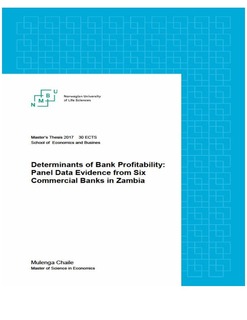| dc.description.abstract | Foreign commercial banks, which are subsidiaries of larger foreign banks, dominate the banking sector in Zambia. The liberalization of the banking sector in 1992 and improved regulatory frameworks following the 2007/2008 financial crisis have made banks to give much attention to profitability. However, no studies have explicitly investigated determinants of bank profitability in Zambia. This thesis contributes towards filling this gap.
In particular, the thesis applied a fixed effects regression model to analyze internal and external factors that affect bank profitability using quarterly panel data on six commercial banks over the period 2010 to 2015 in Zambia.
The empirical results indicate that liquidity risk, bank size and inflation positively affect bank profitability. For example, a 1% increase in liquidity risk increased bank profitability by 2.5%, while a 10% increase in total assets (bank size) raises bank profits by about 3.4%. A percentage point increase in the inflation rate increased profitability by about 1%.
These results imply that the banks under study give out more loans as compared to keeping large amounts of deposits. This gives banks more interest income, which translates into higher profits. In addition, larger banks are able to earn more profits as compared to smaller banks because of economies of scale and from offering a wider range of products. Inflation rate contributes to the profitability of commercial banks in Zambia in that when there is high inflation; interest rates also rise, consequently increasing bank profitability. (However, the effect of inflation is expected to be stronger in nominal terms).
Given, the main results, I recommend that bank managers and staff dealing with credit facilities prioritize giving out loans while also following the lending criteria and putting in stringent measures to avoid defaults. Banks should also give attention to bank size and put in efforts to grow their loan book as it has a bearing on the profitability levels. With regards inflation, the government can also contribute to banks profitability by loosening monetary policy as this will reduce lending rates, ease access to finance and reduce non-performing loans. | nb_NO |

